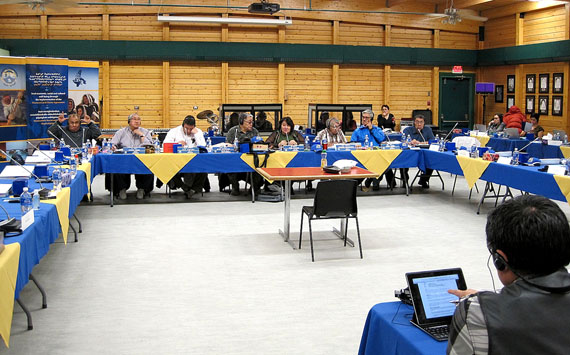Nunavut Inuit org’s board wrestles with money ahead of 2014 AGM
Resource revenue sharing won’t yet include dividends to beneficiaries

The board of Nunavut Tunngavik Inc. meets Oct. 20 at the Luke Novoligak Community Hall in Cambridge Bay. (PHOTO BY JANE GEORGE)
CAMBRIDGE BAY — Money and how to spend it dominated a Nunavut Tunngavik board of directors meeting Oct. 20, held a day prior to the birthright organization’s annual general meeting scheduled to begin in Cambridge Bay Oct. 21.
The board focused on a number of financial considerations, including the distribution of money to hunters as part of an overall revision and updating of NTI’s hunter support policy.
In April 2014, NTI cancelled the program for this year to give the organization time to review it and come up with a five-year plan and strategy for it.
A plan was submitted to the NTI board for review — but the directors rejected it saying it needs more work and consultation.
The board also discussed how to divide future resource revenues — regional Inuit organizations will receive some of the first $100,000 of interest earned by NTI’s Resource Revenue Trust, but individual dividends to beneficiaries will have to wait a long time, until that fund reaches $100 million.
NTI earned only $1.4 million in 2014 and $4.4 million in 2013 from resource royalties from commercial activities on lands where it holds sub-surface rights.
Nunavut Sivuniksavut was also on the meeting’s agenda. Board members are considering a request from the Ottawa-based college program to increase NTI’s contribution to $300,000 because NS revenues have not kept pace with its increased enrolment.
“NTI can increase its contribution, but the federal government will have to increase its contribution,” was how Towtongie responded to the request.
Board members also discussed the Nunavummi Nangminiqaqtunik Ikajuuti policy, now under negotiation between the Government of Nunavut and NTI , for which a memorandum of understanding should be ready in March 2015.
The NNI policy, required by Article 24 of the Nunavut Land Claims Agreement, is meant to favour qualified Inuit-owned or Nunavut-based businesses when they bid on government contracts.
But NTI board members want to use Article 24 to increase the Inuit employment percentage requirements for companies that get GN contracts under NNI.
“Eighty-five per cent of Inuit should be in the workforce,” said Larry Audlaluk, the acting president of the Qikiqtani Inuit Association.
Other board members complained that too many companies, with Inuit-majority ownership on paper, are bringing in their own workforce and equipment to do jobs that could be sourced locally.
Twenty-one delegates will attend the AGM, two from NTI, six from the QIA, five each from the Kivalliq and Kitikmeot Inuit associations, and one delegate each for elders, women and youth.
During the meeting, which wraps up Oct. 23, delegates expect to hear from regional Inuit organizations and the Nunavut Trust, which recently made a presentation at the Kitikmeot Inuit Association AGM in Cambridge Bay.
Delegates are also expected to approve NTI’s financial statements.
Nunavut Premier Peter Taptuna and Inuit Tapiriit Kanatami president Terry Audla are expected to appear Oct. 23.
The 2015 NTI AGM is scheduled for Oct. 20-22 in Iqaluit.





(0) Comments